
The tinfoil barb is a tropical Southeast Asian freshwater fish of the family Cyprinidae. This species was originally described as Barbus schwanenfeldii by Pieter Bleeker in 1853, and has also been placed in the genera Barbodes and Puntius. The specific epithet is frequently misspelled schwanefeldii.

Kenyir Lake is an artificial lake located in Hulu Terengganu, Terengganu, Malaysia, nestled deep in the Pantai Timur Range. The lake was created in 1985 by the Kenyir Dam on the Kenyir River, the upper stream of the Terengganu River. The lake provides water to the nearby Sultan Mahmud Power Station. It is the largest man-made lake in mainland Southeast Asia with an area of 260,000 hectares.

Wallago is a genus of catfishes order Siluriformes of the family Siluridae, or sheatfish. They are found in rivers throughout southern and southeastern Asia. The only extant species of this genus is Wallago attu.

Wallago attu is a freshwater catfish of the family Siluridae, native to South and Southeast Asia. W. attu is found in large rivers and lakes in two geographically disconnected regions, with one population living over much of the Indian Subcontinent and the other in parts of Southeast Asia. This species can reach a length up to 1.1 m.

Siluridae is the nominate family of catfishes in the order Siluriformes. About 105 living species of silurids are placed in 12 or 14 genera.
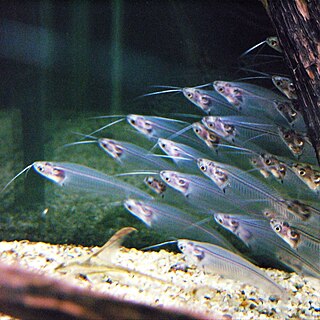
Kryptopterus is a genus of catfishes belonging to the family Siluridae. They are found in freshwater throughout Southeast Asia. The scientific name comes from Ancient Greek kryptós + ptéryx. It refers to the reduced or even entirely absent dorsal fin of these catfishes.
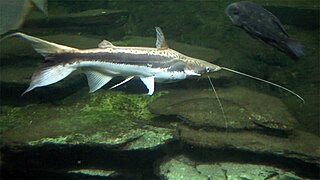
Sorubim is a small genus of long-whiskered catfish native to tropical South America. A number of characteristics allows the differentiation of each species in the genus. Sorubim species are important food fish in South America and are highly significant to fisheries of some areas; however, harvests of these fish are not identified as much as other, more popular food fishes such as Colossoma, Arapaima, and Brachyplatystoma. Some species of this family are popular aquarium fish.
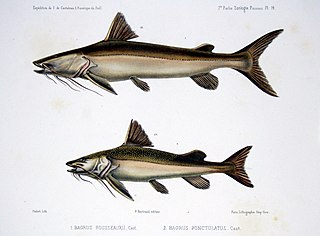
Brachyplatystoma is a genus of catfish from the family Pimelodidae. As the occasionally used common name goliath catfishes indicates, this genus includes some of the largest species of catfish, including the piraíba, B. filamentosum, which reaches up to the region of 3.6 metres (12 ft) in length. Brachyplatystoma are found in the Amazon and Orinoco basins, and other tropical freshwater and brackish habitats in South America. Some species are migratory. These fish are important as food fish and, to some extent, aquarium fish.
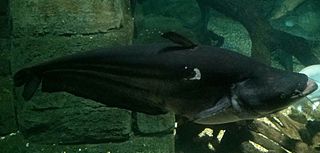
Wallagonia micropogon is a species of catfish in the genus Wallagonia. This species was recently discovered and is found in the Mekong River drainage area between southern Vietnam and northern Laos as well as Chao Phraya River in Thailand. It is a freshwater fish.

The giant pangasius, paroon shark, pangasid-catfish or Chao Phraya giant catfish is a species of freshwater fish in the shark catfish family (Pangasiidae) of order Siluriformes, found in the Chao Phraya and Mekong basins in Indochina. Its populations have declined drastically, mainly due to overfishing, and it is now considered Critically Endangered.

The Java barb, more commonly known as silver barb in aquaculture, is a species of ray-finned fish in the genus Barbonymus.

Hemisilurus is a genus of sheatfishes native to Southeast Asia.

Datnioides microlepis, also known as the Indonesian tiger perch, Indo datmoid, Indonesian tigerfish, or finescale tigerfish, is a species of freshwater ray-finned fish belonging to the family Lobotidae, the tripletails and tiger perches. This species is endemic to the islands of Sumatra and Kalimantan in Indonesia.
Wallagonia maculatus is a species of catfish in the family Siluridae endemic to Malaysia, where it is known only from Sabah in northern Borneo. This species grows up to a length of 100 centimetres (39 in) SL.

Phalacronotus apogon is a species of catfish of the genus Phalacronotus found in Southeast Asia. This species grows to a length of 130 centimetres (51 in) SL.

Datnioides undecimradiatus, the Mekong tiger perch is a species of freshwater fish belonging to the family Lobotidae, the triplefins and tiger perches. This species is endemic to the lower and middle Mekong basin in Indochina.

Wallagonia is a recently established genus of Silurid catfishes, containing 3 distinct species, all of whom are native to Southeast Asia:

The giant red tail gourami is a large species of gourami belonging to the family Osphronemidae. This endangered fish is native to the Southeast Asian island of Borneo, where only known from the Kinabatangan and Segama river basins in Sabah, East Malaysia. First described in 1992 based on an aquarium specimen, its exact range was not entirely certain, leading some source to incorrectly also report it from Indonesia.
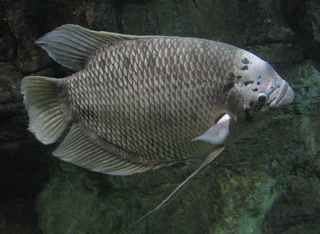
The giant gourami is a species of large gourami native to freshwater habitats in Southeast Asia. It has also been introduced elsewhere. The species is commercially important as a food fish and is also farmed. It can be found in the aquarium trade, as well. The species has been used for weed control on highly invasive aquatic plants like Salvinia molesta, as the giant gourami can be a voracious herbivore.

















